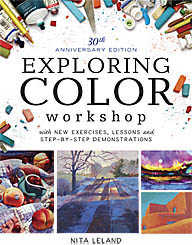Do you know where your art is?
I've always been pretty good at keeping records of all kinds. When I started painting 35 years ago, I recorded every painting I did, including all the student work and the losers. The details helped me remember what I needed to work on. Then I started noting the colors used, paper weight, finish and manufacturer. My record book also shows what source I used for the painting and which were started in workshops. Shows and awards. Purchasers. It has been useful more than once when I wanted to reprise a color scheme in a painting or find out where a painting was. Which is why this is on my mind. Last week my editor at North Light Books requested a 4x5 transparency of one of my paintings that's going to be in my new book. I went to my trusty record book, found the painting listed and discovered that a gallery, now closed, had sold it and I didn't have the name of the collector. What made this even more frustrating was that some months ago someone in one of my watercolor classes told me they owned that painting--and I couldn't remember who had said it. I took it for granted it was in my record book, so I didn't make a note of it. A good memory and a little detective work located the owner. I picked up the painting last night and took it to the photographer's today.
There are three morals to this story. One is to ask your galleries for the names of your collectors. The second is to get quality photos and transparencies made of your best work as soon as you finish it, so you'll have them when you need them for reproductions in books, magazines or giclees. If you're lucky, you'll sell the piece, but it isn't always easy to get a collector to allow you to take it back to have it photographed, no matter what your reason may be. And the third is to keep good records. This is all part of the business of art.
There are three morals to this story. One is to ask your galleries for the names of your collectors. The second is to get quality photos and transparencies made of your best work as soon as you finish it, so you'll have them when you need them for reproductions in books, magazines or giclees. If you're lucky, you'll sell the piece, but it isn't always easy to get a collector to allow you to take it back to have it photographed, no matter what your reason may be. And the third is to keep good records. This is all part of the business of art.
Labels: art business, photography





4 Comments:
Good point, Nita! I sold many paintings in the beginning at outdoor fairs, without keeping track of where they went. I know better now. I'm glad you were able to get your painting back to photograph it.
Michelle
I think galleries fear the artists will try to get to the collectors directly. Unfortunately, some do this, and it isn't an ethical practice. If you're straight up with your galleries, they should trust you with this information.
Hi Nita,
I always scan my pictures when I finish them. With some tweaking in Photoshop, it can be difficult to tell the original from a printout. I MUCH prefer scanning to a photograph -- both will probably need color adjustments and scans start out sharper and a lot closer to the original in my experience -- even when I have to scan them in 4-6 passes (for a large piece) and stitch them together.
Irene--I can see how that might work, but everything depends on the quality of the equipment, whether scanner or camera. Not everyone has a scanner, particularly a good scanner. Nowadays, everyone has a digital camera, but the low-end ones don't take good photos of artwork. I've had two books published since I wrote the original post here. Film transparencies are now history--my publisher prefers digital submissions. They have specific requirements for everything.
Post a Comment
<< Home